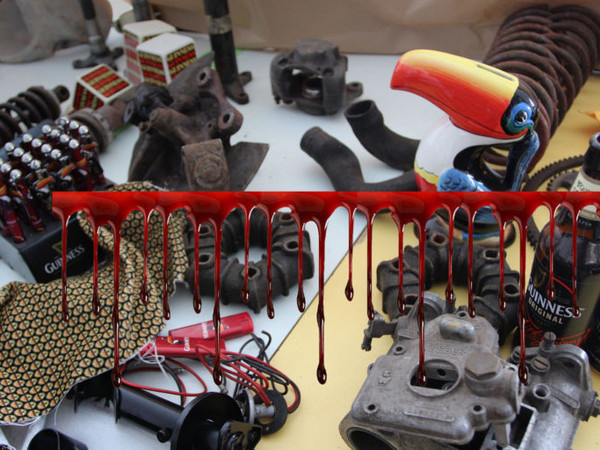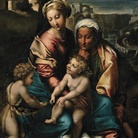James Beckett. The Guinness Curse

© James Beckett
From 21 Marzo 2017 to 21 Aprile 2017
Rome
Place: T293 Gallery
Address: via Ripense 6
Times: Tue-Fri noon to 7pm; Sat 03-07pm
Ticket price: free admittance
Telefono per informazioni: +39 06 88980475
E-Mail info: info@t293.it
Official site: http://www.t293.it/
T293 is proud to present The Guinness Curse, James Beckett’s fourth exhibition at the gallery. The exhibition consists of a new body of thematic work – a series of wall and floor assemblages delving into the bizarrely high occurrence of premature death in the Guinness family. The exhibition touches on speculation, myth, superstition and, inevitably, pop culture itself.
In keeping with Beckett’s vocabulary, the works are developed in a macabre museological sphere, using formal artifacts to legitimatize peripheral narrative. The pieces combine biographical elements from each family member portrayed with merchandise from the brewing company itself – a mélange evoking discomfort through clash. Using display grids, additional planes of custom printed fabrics and tinted glass evoke an austerity, making for an environment of fatality – then memorial.
The Guinness family is a large aristocratic Anglo-Irish Protestant dynasty known for its accomplishments in banking, politics, religious ministry, and even fashion. Most notable, is the Guinness brewery business founded by Arthur Guinness in 1759. Arthur fathered 21 children, of whom only 10 survived to maturity. The “Guinness Curse” (hence the name of this show) has been a recurring media phrase referring to this high death rate; deemed ‘pre-destined’ and somehow doomed to be repeated throughout the family history.
Beckett exploits this casual media naming of a metaphysical damning, integrating elements of both company and person into commemorative displays. “The Curse” is, for this purpose, exaggerated to the point of b-grade horror, with abstract clichés of death appearing, for example, in the form of blood streaks amid snippets of raw nature. This approach sees life in its entirety as inapproachable, instead turning to the extended drama of others as a provisional model for alternative celebrity. In this sense, as a study of yearning and loss, the show spawns a shallow and sinister form of entertainment.
Tara Browne would be a good case in point. A Guinness heir, Tara crashed his Lotus Elan into the back of a parked truck, swerving at the last minute and crushing his own body in order to save the life of his passenger, model Suki Potier. This event is said to have inspired the Beatle song A Day in the Life, with these lyrics: He blew his mind out in a car; he hadn’t noticed that the lights had changed. The display commemorating this particular death uses car-parts from the same model vehicle Tara was driving, together with an array of Guinness toucan aprons.
As the dark stout began to travel the world, the level of hops was boosted to insure that it could remain robust whilst passing the equator in shifting temperatures. As a parallel, two family members are chosen for portrayal, for their formative roles in far-flung corners of the globe:
Walter Guinness, (1st Baron Moyne) was assassinated by the marginal Jewish terrorist group Lehi in Cairo in 1944, due to his role as British Minister of State in the Middle East. As a member of the House of Lords, Walter had travelled extensively, – one such trip being to Papua New
Guinea, a journey which resulted in the publication “Walkabout – A Journey in Lands between The Pacific & Indian Oceans”. The pages of this book appear as excerpts in a series of wall pieces.
Preacher, Henry Grattan Guinness was responsible for training and dispatching hundreds of faith missionaries all over the world, including his own daughter. Lucy E. Guinness published “Across India at the Dawn of the 20th Century” about her hopes of converting the so called “heathen natives” to Christianity. Relentless pages of concerned verse, illustrations, and statistics, paint a portrait of a country in dire need of rescue, all perhaps justifying a role for Lucy, had she not prematurely perished of septicemia. Extracts from these pages and occasional photos form the back-drops of such portraits in “The Guinness Curse”.
James Beckett’s work in diverse media examines subjects of a historical nature, from the development (and subsequent demise) of European industry, to the more metaphysical aspects of dowsing and voodoo. The outcomes of these investigations explore the peculiarity of human behaviour, with craft-like assembly placing the work uncomfortably between a bourgeois decorative art and a crude social reality. Recent shows include: 56th Venice Biennale, Belgian Pavilion (IT); Utopia/Dystopia, MAAT (PT), 5th Thessaloniki Biennale (GR); Artspace, Aukland/Physics Room, (NZ). He has published two monographs: “Works of James Beckett with Constant Interjections by Frank Key”, TWAAS/Koenig books (US); “James Beckett”, Kehrer Verlag (DE).
SCARICA IL COMUNICATO IN PDF
COMMENTI

-
 Dal 31 gennaio 2024 al 04 maggio 2025
Fermo | Palazzo dei Priori
Dal 31 gennaio 2024 al 04 maggio 2025
Fermo | Palazzo dei Priori
-
 Dal 20 dicembre 2024 al 04 maggio 2025
Fermo | Palazzo dei Priori
Dal 20 dicembre 2024 al 04 maggio 2025
Fermo | Palazzo dei Priori
-
 Dal 20 dicembre 2024 al 04 maggio 2024
Gorizia | Palazzo Attems Petzenstein
Dal 20 dicembre 2024 al 04 maggio 2024
Gorizia | Palazzo Attems Petzenstein
-
 Dal 18 dicembre 2024 al 18 dicembre 2024
Venezia | Museo Correr
Dal 18 dicembre 2024 al 18 dicembre 2024
Venezia | Museo Correr
-
 Dal 14 dicembre 2024 al 02 marzo 2025
Palermo | Palazzo Abatellis
Dal 14 dicembre 2024 al 02 marzo 2025
Palermo | Palazzo Abatellis
-
 Dal 12 dicembre 2024 al 23 febbraio 2025
Roma | Palazzo Altemps
Dal 12 dicembre 2024 al 23 febbraio 2025
Roma | Palazzo Altemps


